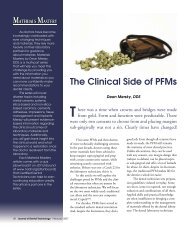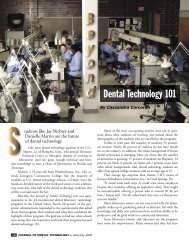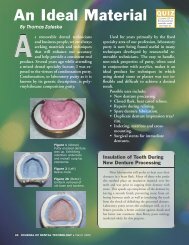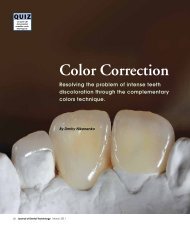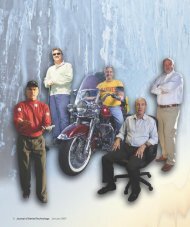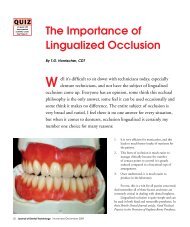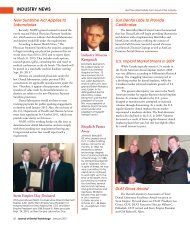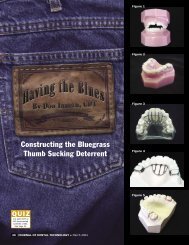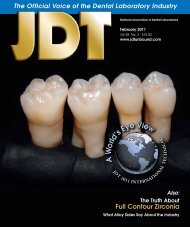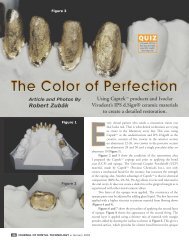20 Journal of Dental Technology April 2007 - JDT Unbound
20 Journal of Dental Technology April 2007 - JDT Unbound
20 Journal of Dental Technology April 2007 - JDT Unbound
You also want an ePaper? Increase the reach of your titles
YUMPU automatically turns print PDFs into web optimized ePapers that Google loves.
<strong>20</strong> <strong>Journal</strong> <strong>of</strong> <strong>Dental</strong> <strong>Technology</strong> <strong>April</strong> <strong>20</strong>07
ences may make<br />
good neighbors,<br />
but the virtual<br />
frontier’s fences <strong>of</strong> closed<br />
architecture can limit your<br />
choices and your success.<br />
Every piece <strong>of</strong> digital<br />
equipment you own from<br />
your cell phone to a CAD/<br />
CAM system has either a<br />
closed or an open system.<br />
In a closed system, the<br />
technological specifications<br />
are proprietary and the<br />
opposite is true in the<br />
case <strong>of</strong> open architecture<br />
systems.<br />
Take you cell phone, for example.<br />
Let’s say you bought a cell phone from<br />
Verizon. In a closed architecture system,<br />
you can only call people who had a<br />
Verizon phone. In an open architecture<br />
system, you can call anyone on any type<br />
<strong>of</strong> phone no matter the type or brand.<br />
The vast majority <strong>of</strong> technology<br />
in the dental laboratory industry<br />
from scanners to complete CAD/<br />
CAM systems is closed architecture.<br />
Manufacturers have been creative in<br />
meeting the needs <strong>of</strong> users without<br />
opening up their systems. For example,<br />
if you want to use the InEos scanner<br />
from Sirona, but don’t want to purchase<br />
the InLab CAD/CAM system or if<br />
you already own a CAD/CAM system<br />
from a different manufacturer, all is not<br />
lost. Sirona started InfiniDent, which<br />
<strong>April</strong> <strong>20</strong>07 <strong>Journal</strong> <strong>of</strong> <strong>Dental</strong> <strong>Technology</strong> 21
allows you to scan a die with InEos and<br />
send the digital information to Sirona’s<br />
production center, where your coping is<br />
manufactured.<br />
It’s a solution, but not a complete<br />
one. The drawback being that because<br />
Sirona’s is a closed system you can’t send<br />
the digital information from your InEos<br />
scanner to a Lava (3M) CAD/CAM<br />
system or any other type <strong>of</strong> CAD/CAM<br />
system not manufactured by Sirona. The<br />
close architecture dilemma has some <strong>of</strong><br />
the leading research and development<br />
technicians looking to see what other<br />
options are available.<br />
“One <strong>of</strong> the things that I’m going<br />
to spend a lot <strong>of</strong> time looking at during<br />
the (International <strong>Dental</strong> Show in<br />
Cologne, Germany) in March is what<br />
else is out there. Open architecture is<br />
going to be the way it’s going to end<br />
up. I think there is going to be pressure<br />
on the big players to open up at least<br />
part <strong>of</strong> their systems to that,” said Jim<br />
Boshoven, CDT, director <strong>of</strong> technical<br />
research at <strong>Dental</strong> Services Group. “I<br />
think if you open it up you encourage<br />
development from a lot <strong>of</strong> other people<br />
and I think you it could drive the<br />
prices down. That’s why I think open<br />
architecture has got some advantages.”<br />
The main advantages <strong>of</strong> open<br />
architecture being:<br />
Choice − You could utilize the same<br />
scanner to manufacture restorations<br />
using different CAD/CAM<br />
systems, whether outsourcing to<br />
another laboratory or using a system<br />
you have in house.<br />
Competition − Different manufacturers<br />
could produce peripheral equipment,<br />
such as a scanner, that would<br />
work with any CAD/CAM system<br />
and produce spare parts to meet<br />
any budget and schedule.<br />
Cost − Competition among<br />
manufacturers and the addition <strong>of</strong><br />
new players to the market could<br />
make it more financially feasible for<br />
small to medium sized laboratories<br />
to participate in CAD/CAM<br />
manufacturing.<br />
So why are there still technological<br />
fences Because manufacturers have to<br />
walk the line between creating products<br />
that are user friendly and maintaining a<br />
healthy bottom line, which allows them<br />
to pay their employees and continue<br />
researching technological advancement.<br />
In addition, manufacturers must agree<br />
on a standard set <strong>of</strong> output parameters.<br />
Manufacturers in Europe are leading<br />
the release <strong>of</strong> more open architecture<br />
systems, while the U.S. is lagging behind<br />
in this respect.<br />
For example, the Switzerland-based<br />
Laserdenta OpenScan 3D scanner was<br />
showing <strong>of</strong>f its five-axis scanner and<br />
computer-aided design modeler at the<br />
Chicago <strong>Dental</strong> Society Midwinter<br />
Meeting in Chicago. The scanner uses<br />
the standard scanning files, known as<br />
STL files, and can be used with any<br />
milling machine, fabrication center or<br />
3D printer that accepts those standard,<br />
open-file formats.<br />
According to the manufacturer, the<br />
five axis give the scanner the freedom <strong>of</strong><br />
movement necessary to precisely digitize<br />
any dental model including undercuts<br />
and abutments. It scans not only models,<br />
but also scans directly from impressions<br />
as well. And while it uses open format<br />
STL file, the drawback to this scanner<br />
is that the most commonly used computer-aided<br />
manufacturing systems in<br />
Laserdenta OpenScan User-Interface<br />
22 <strong>Journal</strong> <strong>of</strong> <strong>Dental</strong> <strong>Technology</strong> <strong>April</strong> <strong>20</strong>07
the U.S., such as Sirona’s inLab or 3M’s<br />
Lava, maintain closed systems.<br />
While many manufacturers say<br />
they are looking into the possibilities <strong>of</strong><br />
open architecture, until more companies<br />
go from looking to committing<br />
laboratory owners will continue to have<br />
limited choices even if they have an open<br />
architecture scanner.<br />
To be sure, there are challenges to<br />
setting a dental industry standard for<br />
open architecture. While many dentists<br />
and technicians doubt manufacturers<br />
will embrace the potential <strong>of</strong> open<br />
architecture, they crave the freedom <strong>of</strong> a<br />
fence-free virtual frontier.<br />
“On my side I want to be able<br />
to use the technician I’ve used my<br />
whole life. I don’t want to be forced,<br />
because I bought this system, to use<br />
some laboratory in another state. I<br />
want to have the option to use my<br />
ceramist here,” said Paul Feuerstein,<br />
DMD, a frequent writer and lecturer on<br />
technology in dentistry.<br />
Boshoven agrees that the<br />
possibilities for dentists and laboratory<br />
technicians abound with open<br />
architecture.<br />
“You’re going to have more options<br />
if you go with the open architecture. To<br />
be able to take the same information and<br />
send it to a number <strong>of</strong> different places or<br />
machines to create it,” he said. “It just<br />
makes sense to me that that’s the way the<br />
industry is going to go because that’s the<br />
way every other industry has gone. We’re<br />
kind <strong>of</strong> an odd industry in many ways<br />
but we’re not that much different.”<br />
LaserdentaCAD Modeler<br />
Open Architecture Basics<br />
What is it<br />
• A system in which the technology’s specifi cations are<br />
made public in order to encourage third-party vendors<br />
to develop add-on products. For example, your<br />
personal computer has open architecture so you are<br />
able to download s<strong>of</strong>tware and add on peripherals,<br />
such as a printer, not manufactured by the company<br />
that built your computer. In the dental laboratory world,<br />
an open architecture CAD/CAM system would enable<br />
you to accept a digital impression, for example, no<br />
matter what system the dentist used.<br />
What are the benefits<br />
• It will create additional competitive sources for<br />
components.<br />
• System integrators would be able to seamlessly connect<br />
different CAD/CAM systems into an effective enterprise.<br />
• You will be able to select from a variety <strong>of</strong> spare parts<br />
sources to meet you budget and schedule.<br />
<strong>April</strong> <strong>20</strong>07 <strong>Journal</strong> <strong>of</strong> <strong>Dental</strong> <strong>Technology</strong> 23





